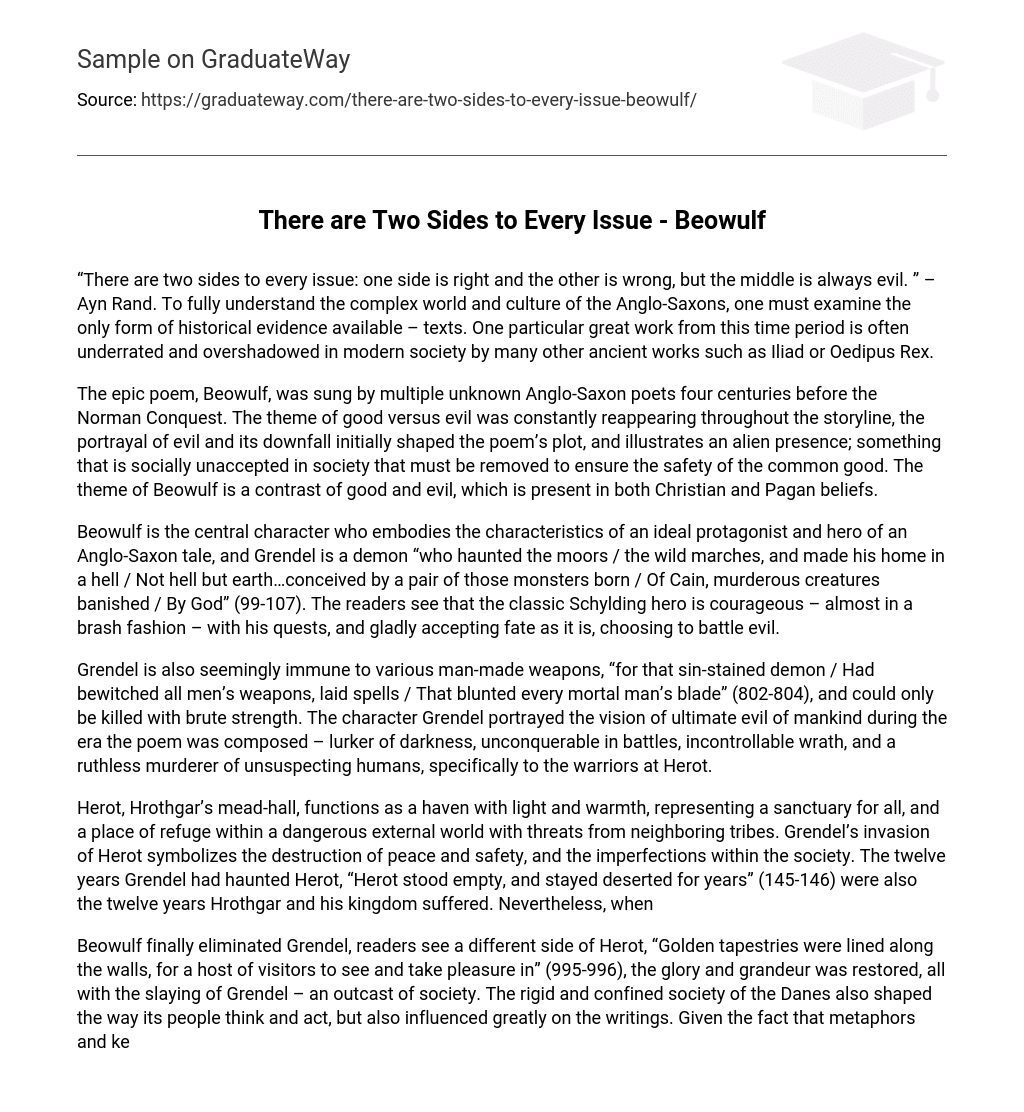“There are two sides to every issue: one side is right and the other is wrong, but the middle is always evil. ” – Ayn Rand. To fully understand the complex world and culture of the Anglo-Saxons, one must examine the only form of historical evidence available – texts. One particular great work from this time period is often underrated and overshadowed in modern society by many other ancient works such as Iliad or Oedipus Rex.
The epic poem, Beowulf, was sung by multiple unknown Anglo-Saxon poets four centuries before the Norman Conquest. The theme of good versus evil was constantly reappearing throughout the storyline, the portrayal of evil and its downfall initially shaped the poem’s plot, and illustrates an alien presence; something that is socially unaccepted in society that must be removed to ensure the safety of the common good. The theme of Beowulf is a contrast of good and evil, which is present in both Christian and Pagan beliefs.
Beowulf is the central character who embodies the characteristics of an ideal protagonist and hero of an Anglo-Saxon tale, and Grendel is a demon “who haunted the moors / the wild marches, and made his home in a hell / Not hell but earth…conceived by a pair of those monsters born / Of Cain, murderous creatures banished / By God” (99-107). The readers see that the classic Schylding hero is courageous – almost in a brash fashion – with his quests, and gladly accepting fate as it is, choosing to battle evil.
Grendel is also seemingly immune to various man-made weapons, “for that sin-stained demon / Had bewitched all men’s weapons, laid spells / That blunted every mortal man’s blade” (802-804), and could only be killed with brute strength. The character Grendel portrayed the vision of ultimate evil of mankind during the era the poem was composed – lurker of darkness, unconquerable in battles, incontrollable wrath, and a ruthless murderer of unsuspecting humans, specifically to the warriors at Herot.
Herot, Hrothgar’s mead-hall, functions as a haven with light and warmth, representing a sanctuary for all, and a place of refuge within a dangerous external world with threats from neighboring tribes. Grendel’s invasion of Herot symbolizes the destruction of peace and safety, and the imperfections within the society. The twelve years Grendel had haunted Herot, “Herot stood empty, and stayed deserted for years” (145-146) were also the twelve years Hrothgar and his kingdom suffered. Nevertheless, when
Beowulf finally eliminated Grendel, readers see a different side of Herot, “Golden tapestries were lined along the walls, for a host of visitors to see and take pleasure in” (995-996), the glory and grandeur was restored, all with the slaying of Grendel – an outcast of society. The rigid and confined society of the Danes also shaped the way its people think and act, but also influenced greatly on the writings. Given the fact that metaphors and kennings are common in Old English literature; the representation of “evil” is also something not to be taken on a literal level. Edgetho had begun a bitter feud / Killing Hathlaf, a Wulfing warrior” (459-460), inter-tribal feuds, therefore, are also a destroyer of peace. Grendel takes on a form that is left uncertain; its real meaning hidden behind the metaphorical mask of a monster, is the never-ending battles between tribal armies (namely, the Danes, Geats, Frisians, and the Swedes) that had disturbed the tranquility people had longed for. It is almost a barrier of peacekeeping, hider of hope.
Hence, it is represented by Grendel, a great evil hated by many, whom humans feared and tried to destroy but with no prevail. After the death of Grendel courtesy of Beowulf, “No victory was celebrated better, / By more or by better men and their king. / A mighty host, and famous, they lined / The benches, rejoicing; the king and Hrothulf, / His nephew, toasted to each other, raised mead-cups / High under Herot’s great roof, their speech / Courteous and warm.
King and people were one; none of the Danes was plotting, / Then, no treachery hid in their smiles” (1013-1019) the two feudal tribes are united and amity is finally restored. Beowulf, the warrior himself, is seen as the representative combination of positive qualities in the warfare society, traits such as selfless bravery, boasting of accomplishments, acceptance of fate, and loyalty to one’s religion are all idealistic hero characteristics that were admired by the Anglo-Saxons, and possessed by Beowulf.
Au contraire, Grendel contains all of the evils that Beowulf had lacked. Grendel is solely guided by animalistic emotions and impulses; and rejoiced at the thought of killing humans, “seeing the hall / Crowded with sleeping warriors, stuffed / With rows of young soldiers resting together, / and his heart laughed, he relished at the sight, / Intended to tear the life from those bodies” (727-731). Such destructive qualities are within Grendel, who ultimately is he peace-bringer himself after his extermination, conjoined the people of Hrothgar and Hygelac that were separated by conflict. Objects that embodied antagonistic traits and representing the dark side of human beings are often cast aside and cause for a society’s distress. A quite obvious fact that is present in the story, but is commonly overlooked by readers, is the character’s separation from society. No normal human being would like a beast with unnatural strength and anger to live among him/her.
Grendel’s alienation from society points directly to his status as an antagonist. Right at the start of the poem, it is clarified that he is shunned by society, labeled by the Danes as an ungodly creature that brings upon consequence for all things under the protection of God. Beowulf, a predestined heroic figure who impersonate “the light” to Grendel’s darkness, choose to take on the quest of slaying the descendent of Cain, in doing so, he removed the fatal threat of society. Achieving eternal fame and respect for himself, but also disposes an assumed evil.





